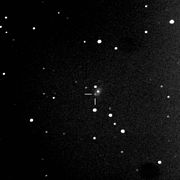Observational astronomy/Supernova
This observing program will study supernovae in distant galaxies. The brightness of a supernova will be measured by analyzing images taken with a digital camera attached to a telescope. These measurements will then be plotted on a graph to show how the brigthness changes over time. This type of graph is called a light curve. The shape of the light curve depends on the physical process that produces the light and it can help to classify the type of supernova that has occurred.
This is an ongoing project which will continue through the spring of 2007. The process of collecting and analyzing the data will be documented here. If you are interested in joining this learning group please leave a message at the talk page.
Observing session 1[edit | edit source]

The first target observed is SN 2006sr which was discovered by Doug Rich on 12 December 2006. The supernova is located in the galaxy UGC 14 which is at a distance of about 100 megaparsecs. It is a Type Ia supernova.
A series of images were taken on 21 December 2006 using a 16" Meade telescope with an ST-L digital camera. A sample raw image is shown on this page. The purpose of taking these images was to determine the feasibility of making observations of dim supernovae from an observatory located in a urban environment. The results will also be used to refine the procedures for taking images to improve the quality of the data.
These images were taken without a filter and with exposure times of 60 and 20 seconds. The supernova was easily detected in the images. However, the signal-to-noise ratio (SNR) is rather low. This will make it more difficult to get a precise measurement of the brightness. The background noise could be due to light pollution and the amount of background noise might depend on the weather conditions at the time of observation. Another method of increasing the SNR is to take multiple images and use computer software to "stack" them.
Plan[edit | edit source]
Followup observations of SN 2006sr were made on Dec. 28 and 29. On Dec. 29 a second target was also observed. SN 2006td was discovered on Dec. 24 by Wolfgang Kloehr. It is a Type Ia in the galaxy LEDA 74050. On Jan. 2 the two supernovae were observed again, along with a third target. SN 2006rs is a Type Ia in the galaxy IC 28. It was discovered Nov. 11 by the Nearby Supernova Factory.
- Images of supernova 2006sr
- Images of other supernovae
References[edit | edit source]
- CCD Observing Manual - a basic introduction to using a CCD camera to observe and measure the brigthness of stars
- Supernova Photometry - a technical lecture on photometry as applied to the study of supernovae
- Monitoring Type Ia Supernovae - a discussion on measuring supernovae (includes a diagram showing a typical light curve)
- Latest Supernovae - list of the currently observable supernovae
- Supernovae Home Page - observations, images, measures and light curves for recent supernovae
- List of Recent Supernovae - a complete list of newly discovered supernovae








